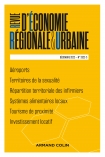
Revue d'économie régionale et urbaine (5-6/2018)
Pour acheter ce numéro, contactez-nous
Recevez les numéros de l'année en cours et accédez à l'intégralité des articles en ligne.
L’« École française de la proximité » (EP) s’est constituée parallèlement à l’affirmation en France de deux courants économiques hétérodoxes un temps confondus : la Théorie de la Régulation et l’Économie des Conventions (respectivement TR et EC). Ainsi certains membres de l’EP ont affirmé leur parenté avec l’un et/ou l’autre de ces courants, et une confrontation a persisté au sein de l’EP au sujet de la proximité non géographique, déclinée en proximité organisée (approche interactionniste), ou selon une double notion de proximité institutionnelle et organisationnelle (approche institutionnaliste). Il se dégage chez certains auteurs proximistes une tendance pour évacuer la notion d’institution tout en se revendiquant institutionnaliste. Après une présentation des différentes approches de la proximité, nous examinons ensuite les relations entre la TR et l’EC. En conclusion, nous considérons que le primat de la proximité institutionnelle devrait conduire l’École de la Proximité à se situer plutôt du côté de l’institutionnalisme, porté notamment par la TR.
The « French School of Proximity » (EP) was formed, parallel to the assertion in France of two heterodox economic currents, once confused: the Theory of Regulation (TR) and the Economics of Conventions (EC). Thus, some members of the « French School of Proximity » affirmed their kinship with one and / or the other of these currents, and a confrontation persisted in the « French School of Proximity » about the non-geographical proximity, declined in organized proximity (interactionist approach), or in institutional and organizational proximity (institutionalist approach). In some texts of proximist authors, there is a tendency to evacuate the notion of institution while claiming to be institutionalist. After a presentation of the different approaches to proximity, we will then examine the relationship between TR and EC. In conclusion, the primacy of institutional proximity should lead the School of Proximity to be placed rather on the side of the institutionalism carried, particularly, by the TR.

